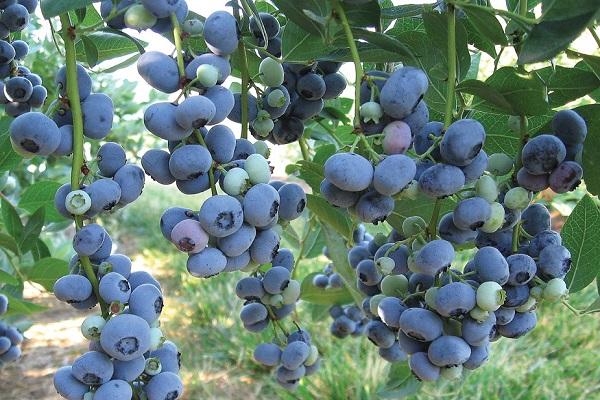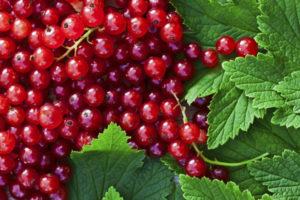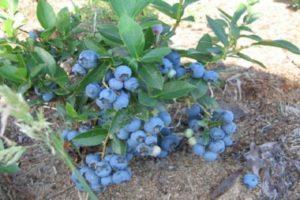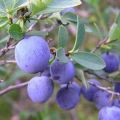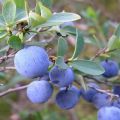Description and characteristics of the Bluegold blueberry variety, planting rules and care
Blueberries are very popular with experienced or novice gardeners. The exotic culture is not only tasty, but also healthy. The plant perfectly decorates the garden, creates a romantic atmosphere. The variety became popular over 100 years ago in the CIS countries. To successfully grow blueberries, you should familiarize yourself with all its features.
History of origin
The tall blueberry bush Bluegold was bred in 1989, a variety native to America. A. Draper became the discoverer. When working on a varietal crop, tall berry forms were used, growing in the marshlands of the United States. Blueberries became immediately popular and gained recognition in America and Europe. By the end of the 1990s, the variety was discovered by gardeners from the former USSR.
Main advantages and disadvantages
Bluegold shrubs offer a number of positive and negative qualities. The negative aspects can be leveled by observing agronomic techniques.
| pros | Minuses |
| Dense, juicy blueberry pulp | Rapid growth of bushes |
| Long term storage, easy transportability | Berries fall off after ripening |
| High productivity of the bush | In the heat, the fruits are baked |
| Self-fertile variety | |
| High resistance of the bush to frost |
Description of berries
Bluegold blueberries differ from other varieties in these features.
- The taste appears at the same time as the berries ripen. Fruits are colored much earlier than ripening. They are easily separated from the fruit stem, and when they ripen, they quickly crumble.
- Berries are light blue in color, rounded. Average size, diameter 15 cm, weight 2.1 grams. Juice without a pronounced color, the pulp includes many seeds.
- Blueberries have a sweet and sour taste, the sugar content is 9.6%. The variety received a tasting score of 4.3 points.
The variety of berry bushes is worthy of cultivation, does not require painstaking care.
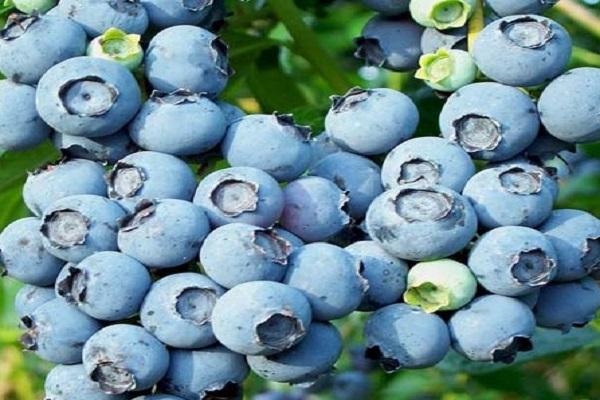
Bush and roots
Blueberry is a perennial deciduous shrub, the rhizome is fibrous, branched. It is located at a depth of 40 cm.
- The bush grows up to 1.2 meters high.
- There are many erect shoots.
- The branches are strong, 3 cm in diameter.
- Leaves in the shape of an ellipse.
The foliage changes color by the end of August. In September, the bushes turn crimson.
Flowering and fruiting
Blueberries begin to bloom in the first half of June, bloom lasts until early July, 20 days. The variety bears fruit in early August, but the fruit may ripen sooner or later, depending on the climatic conditions of the region. The plant is considered mid-season, producing fruits after 3 years of life. The greatest amount of the harvest ripens after 6 years from planting. From one shrub, you can collect up to 5 kilograms of blueberries.
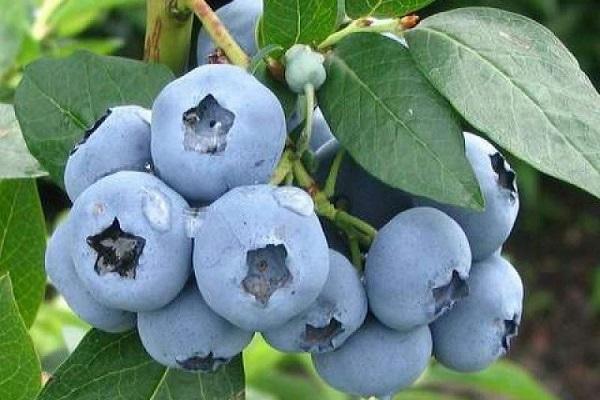
How to use blueberries
Blueberries are widely used to create blanks for the winter; jams, preserves, compotes, candied fruits are made from it. You can eat fresh berries, freeze in the refrigerator. They do not lose their color for about 2 weeks after being plucked from the stalk. Before placing the fruits in a wooden box or plastic container, sort them out, leaving only whole, healthy specimens.
Susceptibility to disease and insect bush
The blueberry variety is famous for its high resistance to diseases, insects, but sometimes it suffers from fungi. The plant is affected by cytosporosis, phyllostic spotting, septoria. Among the harmful beetles are leafworms, heather lancet, moths.
Resistant to freezing temperatures and drought
Blueberries Bluegold can withstand temperatures as low as -35 degrees. If frosty winters prevail in the region, cyclones are long, the bush may disappear. In the South, the plant survives safely in the cold season.
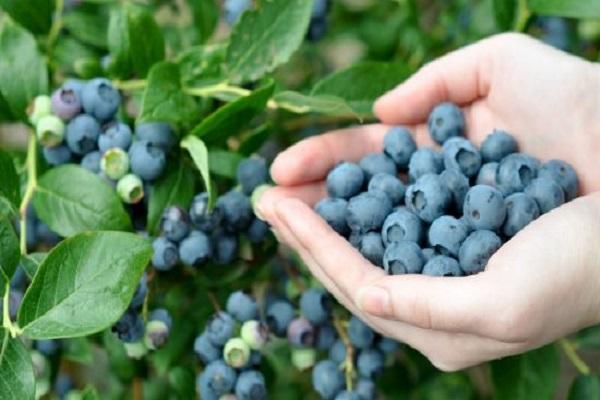
Planting recommendations
Planting blueberries in the right place and timing. The plant should take root, the seedlings should develop a root system by the onset of frost. The soil should be chosen fertile, where such crops have not previously grown. The berry does not imply special planting technologies.
Landing dates
It is advisable to plant blueberries in the spring, before bud break. In the fall, planting operations are undesirable because the weather is unpredictable. It is important that 2 months remain before the first cold weather. Only then will the shrub adapt to the new habitat and will not die in winter.
Selection of berry seedlings
Experienced gardeners advise buying 1 or 2 year old planting material. It better tolerates the stress of planting in open ground. Shrubs should be sought from trusted sellers or specialized stores. It is undesirable to buy on the market, you can get a wild-growing seedling or the wrong variety. Before paying, inspect the seedling for integrity, it must be healthy, with a graft. The roots are strong, without scratches, chips.
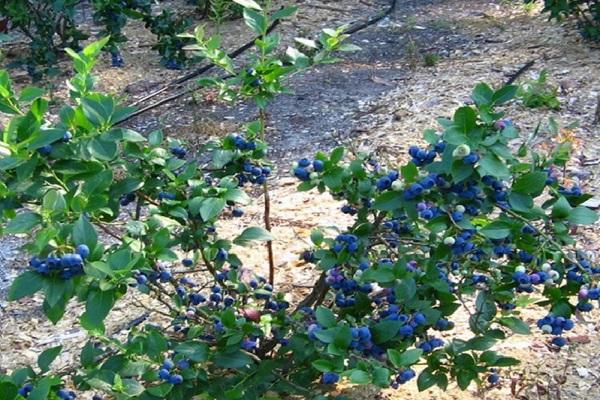
Preparing the soil and planting pit
Blueberries grow well on acidic soil, pH 5.0-5.5. If the soil does not meet the above criteria, fresh manure, needles, peat, colloidal sulfur are added to it, or the intended place is watered with acetic, citric acid. The substrate should be lightweight, breathable. In heavy soil, blueberries will not grow well or will die out.
The rhizome is superficial, the average depth of the hole should be 40 cm, diameter - 0.5 meters. When planting, at the same time between the seedlings maintain a distance equal to the volume of an adult bush. At the bottom, a drainage layer 5 cm thick is made. It consists of brick chips, expanded clay, pebbles, and clay shards. A mixture of peat, river sand, coniferous sawdust is placed in the depression. The components are taken in the same proportion.
Nitroammofoska, Azofoska, Diammofoska, 40 grams each, are added from the feed. Mycorrhiza is added to the landing recess. This is a kind of "fringe" on the tips of the rhizomes of plants of the Heather family. Mycorrhiza helps the bush develop properly. If the planting material was purchased from the nursery, nothing needs to be added, the "fringe" is already present in the top layer of the soil.
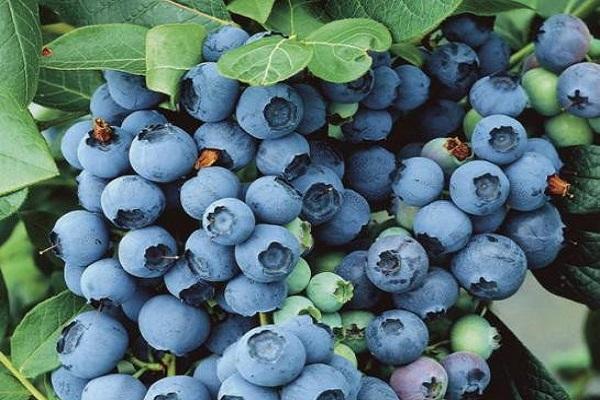
It should be preserved, as should the water where the seedling has been soaked. Only a planted bush is watered with it. Mycorrhiza is bought as a dry concentrate in garden stores.You can get it yourself by going to the forest where blueberries, lingonberries, and cranberries grow. Cut a small amount of sod with rhizome, chop, add to the hole.
Bush planting technology
A competent choice of a site for planting blueberries is the key to a bountiful harvest in the future. It is advisable to give preference to areas well-lit by the sun. Lack of heat has a detrimental effect on the palatability of the fruit, they acquire a sour taste, the skin becomes coarser. Groundwater should run closer than 50 cm to the surface, or you will have to make a hill 20 cm high.
Avoid places with constant drafts. The site must sometimes be ventilated, otherwise the attacks of pathogenic fungi cannot be avoided.
Specificity of berry care during the season
Blueberries require proper care that doesn't take long.
- Timely watering, weeding, fertilization.
- Bush pruning.
- Treatment for diseases, harmful insects or prevention.
Sometimes blueberry bushes need shelter for the winter..

Irrigation and top dressing
The soil under the pits must be kept moist, irrigating the soil by 20 cm. If you over-water, moisture stagnation is possible. This is fraught with negative effects on the rhizome. The earth should hold its shape in a fist and crumble when thrown to the floor. This indicates sufficient moisture.
In dry periods and heat, water the bushes every 3 days, pouring 10-15 liters per bush. Pour water at the root, not on it. Sprinkler irrigation is the best watering option. It is not necessary to irrigate the blueberries during rainy or cool weather. Every 2 weeks, water the plant with a solution of acetic acid, taking 2 ml or 5 g of colloidal sulfur, dissolving in 10 liters of water. Then, 3-4 times during the growing season, carry out loosening, keeping the old layer of mulch, adding a fresh one.
Weeding and mulching bush beds
It is advisable to feed blueberries periodically with phosphorus, potassium and nitrogen. The last substance is introduced first of all, in 2 approaches - from the first days of May and towards the end of the month. In June and late July, feed only with potassium and phosphorus.
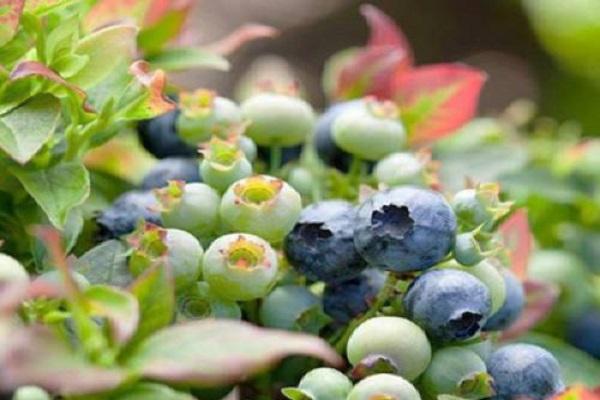
Berry pruning procedure
The formation of a bush is a necessary measure, which is carried out 6 years after planting. Remove damaged, overgrown, frozen branches. Use sharp pruning shears, and sprinkle the pruning site with an antiseptic - wood ash, chalk or activated carbon. This will help to protect blueberries from penetration of pathogenic bacteria and fungi into the cut sites. Correct pruning guarantees a bountiful harvest in the future. It is carried out in early spring or mid-autumn.
The procedure should be carried out 2 times a year. More rare pruning entails a strong overgrowth of branches with an abundance of small, sour berries.
Preparing bushes for winter
Blueberries tolerate cold well. If the bush is covered with snow, with a layer of more than 50 cm, no additional measures are needed. From time to time you should only add a snow layer. To protect the bushes from rodents, wrap them with a chain-link or close them with spruce branches, tying them with twine.
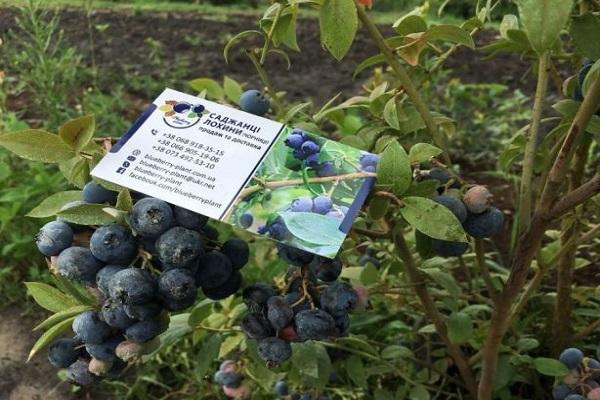
Harvesting and storage
If the blueberry comes off easily from the stem, the crop can be harvested. It is not worth the time with the procedure, as the berries may crumble. Start cleaning after the dew has dried, from top to bottom through the bush. Blueberries are kept in containers lined with paper or cloth for up to 15 days. On the shelf of the refrigerator compartment, fruits are stored for up to six months. Vitamins are perfectly saved when making mashed berries with added sugar.

Variety reviews
Reviews of Bluegold blueberries will help you make your choice, learn more about the variety.
Dmitry Kovalenko, 70 years old, Kiev.
Greetings! I have been doing gardening for over 15 years, all summer I live in the country. I have been growing blueberries since 2005, I preferred the Bluegold variety.The bush blooms beautifully, the berries are delicious, no special care is required. The plant was attacked by aphids and fungi 3 times. He removed the infection with chemicals and Bordeaux liquid. There were no more problems. I advise everyone!

Roksolana Ignatieva, 68 years old, Dnipro.
Hello! I have been growing Bluegold blueberries for 7 years. The harvest is stable, I make jam from berries, excellent jam, I decorate ice cream with them. All the neighbors are jealous, I do not treat them with tasty fruits, and my work colleagues - regularly. I recommend everyone to grow this unpretentious berry bush. You don't need to mess with it, and the quality of the crop is at the highest level.
Petr Hovsepyan, 59 years old, Zaporozhye.
Hello to all! I heard about the Blueberry Bluegold berry variety back in the late 1990s, on the market. I decided to try out the culture in 2008. I planted 5 bushes at once. The berries grew large, incredibly tasty. He looked after the bush, as it should be, watered and fertilized. Since there are many fruits, I sell them to my work colleagues, everyone is happy.
